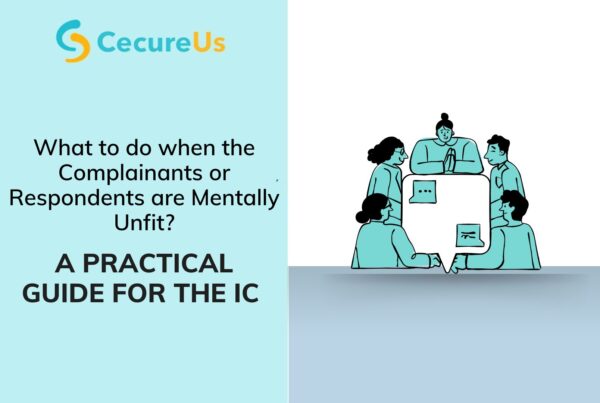
The Sexual Harassment of Women at Workplace (Prevention, Prohibition and Redressal) Act was passed in 2013 by the Indian parliament to lay down the policies for complaints and inquiries of sexual harassment of women in workplaces and guidelines for the actions to be taken in cases of sexual harassment. Broadening the Vishaka guidelines, The Prevention of Sexual Harassment act protects all women employees who are not just employed by the organizations, but third parties, clients, or anyone who visits the premises at any capacity against sexual harassment at the workplace.
This being defined, almost all organizations across the country have implemented policies of sexual harassment prevention in workplaces and are training their employees to be compliant. However, there are a few concerns among new organizations, a few small-scale organizations, and those companies with fewer employees about compliance with the PoSH act. This article answers a few FAQs about compliance with the Prevention of Sexual Harassment/PoSH act 2013 and defines 6 steps by which any organization can become compliant with the PoSH act and prevent sexual harassment incidents in their workplaces.
FAQ 1:
What if my organization has all male employees? Should I be compliant with the Prevention of Sexual Harassment Act?
Answer:
Yes, The PoSH Act?mandates?compliance with the Prevention of Sexual Harassment policies for any organization with a?minimum of 10 employees.?Now, it is imperative to understand that even if all the employees of the organization are male, they have to interact with female vendors, clients, and other female parties visiting or associated with the organization. All employees should be sensitized to comply with the PoSH laws and policies and should be trained to report sexual harassment incidents in the workplace.
FAQ 2:
What if my organization has only contractors or consultants? Should I be compliant with the PoSH law?
Answer:
Yes, the PoSH Act defines an employee as an individual?associated with the organization in any form, whether working with or without pay, full-time or part-time. Be it schools, colleges, educational institutes, NGOs, Government, or private organizations, if the organization has more than 10 employees, compliance with the PoSH Act is mandatory.
Steps for compliance:
Define Clear Policies:
An organization must begin compliance by defining clear policies for the Prevention of Sexual Harassment in the workplace.?The definitions of workplace, employees, and harassment should be clearly and explicitly mentioned in the policy handbook and handed to all employees. The guidelines on reporting a sexual harassment incident, the timeline for reporting, how to register an incident and with whom, details of the Internal Committee, and the consequences for harassment should be published in the policies. All employees associated with the organization must be trained and sensitized about the same.
Set up an Internal Committee:
The second step to compliance is to form an Internal Committee(IC) to receive, inquire about, and redress complaints on sexual harassment incidents in the workplace. The committee should constitute a minimum of 4 people, headed by a senior woman. An external member, not a part of the organization, must be included in the IC to ensure fair practices in inquiries and redressals of sexual harassment complaints.
Empower the Internal Committee and employees:
According to the PoSH law, all members of the Internal Committee must be trained to receive, handle, and prevent sexual harassment incidents in workplaces. The IC must be trustworthy and relied upon by all employees of the organization for fair practices against sexual harassment.
Periodically train all employees about harassment and reporting, empower all employees to speak up, and take a stand against sexual harassment in the workplace.
Routine training can happen in any form, like classroom mode, e-learning, induction, and paper-based, to name a few, but it must be mandatory for all employees irrespective of their rank and file.
Penal consequences of sexual harassment:
Display the penal consequences of harassment and violation of the PoSH Act on the notice boards, in conspicuous places like lobbies, cafeterias, washrooms, floor notice boards, etc. The posters should also mention that the workplace is harassment-free, and if any visitors are harassed by employees of the organization, they must report to the authorities. Awareness about the consequences can form the foundation for preventing sexual harassment incidents in the workplace.
Display in service rules that sexual harassment is punishable by law:
Every employee new to the organization must be made aware that sexual harassment is a punishable offense under the PoSH Act 2013, and the organization must ensure that. The service regulations of employment must display the code of conduct accordingly and be clear in this aspect. The rules and employee compliance with the PoSH Act must be a part of the induction program.
PoSH Reports:
The organization must prepare a detailed report of PoSH compliance, training, the cases handled, and the details and hand it over to the district office annually. This has to be done and filed with the district office for every branch of an organization.
By following these 6 simple steps, an organization can ensure 100% compliance with the Prevention of Sexual Harassment Act, offering safe workplaces for all employees and third parties.
For any queries on PoSH Act compliance, write to us at connect@cecureus.com. For more blogs and articles, visit our?official website.??Contact us?for workshops and queries related to?POSH,?EAP(Employee Assistance Program,)?and?Diversity and Inclusion.




